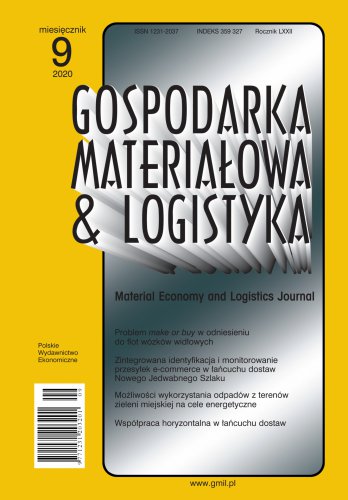The life cycle of rubber waste for used car tires
The lifecycle of rubber waste, based on the example of used tires is presented in this paper. The main focus is put on the methods of the waste management and further utilization. This is considered and described in details in relation to the situation in Poland over the period of 2015- 2017. The aim of the article is to propose new solutions that will allow to "control" the number of tires introduced to the market through legislative solutions. An analysis of the current way of managing used tires may allow for their better use and disposal. Complementary to the major considerations, the legislative conditions regarding the utilization of rubber waste are introduced (the status obligatory to 01.03.2020).
References
Bibliografia/References
Adamczyk, W., Niklewicz, T., Rychwalski, M. (2013). Wykorzystanie metody LCA do ekologicznej oceny opon samochodowych. Gospodarka Materiałowa i Logistyka, (3) s. 11.
Aylon, E., Fernandez-Colino, M., Navarro, R., Murillo, R., Gracia, T., Mastral, A. M. (2018). Waste Tire Pyrolysis: Comparison between Fixed Bed Reactor and Moving Bed Reactor. Industrial & Engineering Chemistry Research, 47, 4029–4033. https://doi.org/10.1021/ie-071573o
Bockhorn, H., Seidelt, S., Muller-Hagedorn, M. (2006). Description of tire pyrolysis by thermal degradation behaviour of main components. Journal of Analytical and Applied Pyrolysis, 75, 11–18. http://doi.org/10.1016/j.jaap.2005.03.002
BRV (2010). Erneute Diskussion zum Thema Reifenalter, Statement vom BRV-Justiziar.
Brzustewicz, P. (2013). Zarządzanie łańcuchem dostaw a cykl życia produktu — perspektywa rozwoju zrównoważonego. Marketing i Rynek, (12), 8–13.
Darmstadt, H., Roy, C., Kaliagljine, S. (1995). Characterization of pyrolytic carbon blacks from commercial tire pyrolysis plants. Pergamon, 33(10), 1449–1455. https://doi.org/10.1016/0008-6223(95)00096-v
Główny Urząd Statystyczny (2017). Produkcja wyrobów przemysłowych w 2016 roku, Warszawa.
Główny Urząd Statystyczny (2018). Produkcja wyrobów przemysłowych w 2017 roku, Warszawa.
Gronowicz, J., Kubiak, T. (2007). Recykling zużytych opon samochodowych. Problemy eksploatacji, (2), 5–18.
Jakóbiec, J., Żmuda, W., Budzyń, S., Wysopal, G. (2011). Recykling energetyczny zużytych opon. Autobusy Technika, Eksploatacja, Systemy Transportowe, (10), 205–211.
Nelson, D. (1987). Mass Production and the U.S. Tire Industry. Journal of Economic History, 47(2), 329–339.
Rathsack, P., Riedewald, F., Sousa-Gallagher, M. (2015). Analysis of pyrolysis liquid obtained from whole tyre pyrolysis with molten zinc as the heat transfer media using comprehensive gas chromatography mass spectrometry. Journal of Analytical and Applied Pyrolysis, 116, 49–57. http://doi.org/10.1016/j.jaap.2015.10.007
Singh, R., Ruj, B., Jana, A., Mondal, S., Jana, B., Sadhukhan, A., Gupta, P. (2018). Pyrolysis of three different categories of automotive tyre wastes?: Product yield analysis and characterization. Journal of Analytical and Applied Pyrolysis, 135, 379–389. https://doi.org/10.1016/j.jaap.2018.08.011
Smejda-Krzewicka, A., Olejnik, A., Dmowska-Jasek, P. (2016). Przegląd metod recyklingu opon. Eliksir, (2), 12–15.
Wang, W., Bai, C., Lin, C., Prakash, S. (2016). Alternative fuel produced from thermal pyrolysis of waste tires and its use in a DI diesel engine. Applied Thermal Engineering, 93, 330–338. https://doi.org/10.1016/j.applthermaleng.2015.09.056
Wojciechowski, A., Dyduch, J., Wołosiak, M. (2014). Pozyskiwanie paliw alternatywnych z recyklingu termicznego elastomerów pochodzących z pojazdów wycofanych z eksploatacji. Logistyka, (3), 6720–6728.
Wojciechowski, A., Michalski, R., Kamińska, E. (2012). Wybrane metody zagospodarowania zużytych opon. Polimery, 57(9), 656–660. https://doi.org/10.14314/polimery.2012.656
Zieliński, M. (2013). Efektywność działań personalnych w cyklu życia produktu. Zeszyty Naukowe. Organizacja i Zarządzanie. Politechnika Śląska, 66, 11–21.

